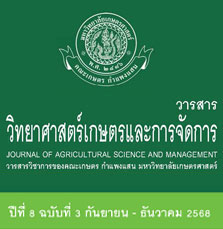The Using of SRAP DNA Markers to Identify the Mycelium of Oyster Mushroom and Cordyceps militaris
Keywords:
mushroom identification, molecular markers, PCRAbstract
The Pleurotus and Cordyceps mushrooms are popular among consumers due to their rich nutritional and medicinal benefits. Pleurotus mushrooms are easy to grow and inexpensive, while Cordyceps mushrooms must be grown in aseptic conditions and are quite expensive. The classification of these two genera can be easily done by morphological characterization during the fruiting body stage. However, in the early stage of mycelial growth, morphological characterization is unsuccessful due to their resemblance. The objective of this study was to utilize SRAP DNA markers to discriminate between Pleurotus and Cordyceps mushroom species in an early mycelial stage, which will benefit genetic improvement through protoplast fusion. In this study, two cultivars of
P. ostreatus, the Phoenix oyster mushroom and the Bhutan oyster mushroom, and C. militaris were investigated.
A total of one hundred SRAP primer pairs (Me1-10/Em1-10) were examined. The results revealed that 57 primer pairs can be used to discriminate C. militaris from the two oyster mushrooms. Additionally, 33 primer pairs successfully discriminated between the Phoenix oyster mushroom and the Bhutan oyster mushroom. However, only 16 pairs of primers allowed for discrimination between these two P. ostreatus cultivars and C. militaris.
References
กรมวิชาการเกษตร. 2556. ความรู้ทั่วไปเกี่ยวกับเห็ด. (ระบบออนไลน์). แหล่งข้อมูล: http://www.aopdh02.doae.go.th/ wonlop_het.pdf (15 ธันวาคม 2565).
กลุ่มงานจุลชีววิทยาประยุกต์. 2541. ข้อมูลเชื้อพันธุ์เห็ดบริการ. กองโรคพืชและจุลชีววิทยา กรมวิชาการเกษตร กระทรวงเกษตรและสหกรณ์. โรงพิมพ์ชุมนุมสหกรณ์การเกษตรแห่งประเทศไทย จำกัด, กรุงเทพมหานคร. 21 หน้า.
เยาวภา ทองอร่าม. 2558. การศึกษาเปรียบเทียบการเพาะเลี้ยงถั่งเช่าสีทองโดยใช้หัวเชื้อเหลวและหัวเชื้อแข็งของ Cordyceps militalis บนเมล็ดธัญพืช. วารสารวิชาการโรงเรียนนายร้อยพระจุลจอมเกล้า 13(13): 87-99.
เรือนแก้ว ประพฤติ และปรีชา รัตนัง. 2553. การรวบรวมและจําแนกสายพันธุ์เห็ดหอมที่เพาะเป็นการค้าด้วยเครื่องหมายโมเลกุลอาร์เอพีดี. วารสารเกษตร 26(2): 137-145.
สุรินทร์ ปิยะโชคณากุล. 2552. เครื่องหมายดีเอ็นเอ: จากพื้นฐานสู่การประยุกต์. สำนักพิมพ์มหาวิทยาลัยเกษตรศาสตร์, กรุงเทพมหานคร. 269 หน้า.
อุราภรณ์ สอาดสุด, วิชชา สอาดสุด, ธวัช ทะพิงค์แก, ศิริพร หัสสรังสี, นภาวรรณ โฆษิตเรืองชัย, อรอนงค์ อาร์ตีโร, เพ็ญศิริ
ศรีบุรี, และสุรพันธ์ กาญจนวงศ์. 2552. การควบคุมคุณภาพและยืดอายุหลังการเก็บเกี่ยวเห็ดสกุลนางรม. ศูนย์นวัตกรรมเทคโนโลยีหลังการเก็บเกี่ยว มหาวิทยาลัยเชียงใหม่. 106 หน้า.
Atila, F., Y. Tüzel, B. Çakir and D. Erogul. 2018. Genetic diversity analysis of Hericium isolates by ISSR and SRAP markers. Journal of Microbiology, Biotechnology and Food Sciences 7(5): 532-536.
Chang, S.T. and P.G. Miles. 2004. Mushrooms-Cultivation, Nutritional Value, Medicinal Effect, and Environmental Impact. 2nd Edition. CRC Press. Boca Raton. 477 p.
Das, S.K., M. Masuda, A. Sakurai and M. Sakukabara. 2010. Medicinal uses of the mushroom Codyceps militaris: Current state and prospects. Fitoterapia 81(8): 961-968.
Dube, H.C. 2013. An Introduction to Fungi. 4th Revised Edition. Scientific Publishers. Jodhpur, India. 603 p.
Huang, C.Q., G.D. Liu, C.J. Bai, W.Q. Wang and J. Tang. 2014. Application of SRAP markers in the identification of Stylosanthes guianensis hybrids. Molecular Biology Reports 41: 5923–5929.
Li, G. and C.F. Quiros. 2001. Sequence-related amplified polymorphism (SRAP), a new marker system based on a simple PCR reaction: its application to mapping and gene tagging in Brassica. Theoretical and Applied Genetics 103: 455-461.
Regula, J. and M. Siwulski. 2007. Dried shitake (Lentinulla edodes) and oyster (Pleurotus ostreatus) Mushrooms as a good source of nutrient. Acta Scientiarum Polonorum Technologia Alimentaria 6(4): 135-142.
Ren, N., J. Liu, D. Yang, J. Chen, M. Luan and J. Hong. 2012. Sequence-related amplified polymorphism (SRAP) marker as a new method for identification of endophytic fungi from Taxus. World Journal of Microbiology and Biotechnology 28: 215–221.
Winkler, D. 2008. Yartsa Gunbu (Cordyceps sinensis) and the fungal commodification of Tibet’s rural economy. Economic Botany 62(3): 291-305.
Zhang, H., L. Fu, X. Wu, H. Li, H. Wei, Q. Wu and L. Wang. 2009. Identification of protoplast fusion hybrids of Ganoderma lucidum by SRAP analysis. Acta Edulis Fungi 16(04): 9-13.






